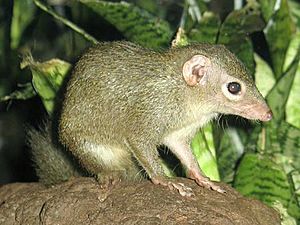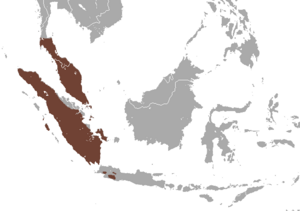Common treeshrew facts for kids
Quick facts for kids Common treeshrew |
|
|---|---|
 |
|
| Conservation status | |
| Scientific classification | |
| Genus: |
Tupaia
|
| Species: |
glis
|
 |
|
| Common treeshrew range | |
The common treeshrew (Tupaia glis) is a small mammal that looks a bit like a squirrel. It lives in countries like Thailand, Malaysia, and Indonesia. This animal is part of the treeshrew family, called Tupaiidae. Scientists say it's not in danger of disappearing right now, even though its home is sometimes shrinking.
Contents
What Does the Common Treeshrew Look Like?
The common treeshrew is one of the bigger treeshrews. Its body is usually about 16 to 21 centimeters (6 to 8 inches) long. It weighs around 190 grams (about 6.7 ounces).
These animals can be reddish-brown, greyish, or black on top. Their bellies are usually whitish. They have a long, bushy tail that is dark greyish-brown. This tail is almost as long as their body! Their paws are bare with sharp nails. They also have a small patch of skin above their long nose. Both male and female treeshrews look very similar. You can often spot a common treeshrew by the pale, white stripe on each of its shoulders.
There are two main types, or subspecies, of common treeshrews: T. g. longipes and T. g. salatana. The T. g. longipes is usually a bit duller in color. Its belly is a light tan or reddish-tan, and the underside of its tail is greyish. The T. g. salatana has darker reddish fur on its belly and the underside of its tail.
Where Do Common Treeshrews Live?
Common treeshrews live in southern Thailand, throughout mainland Malaysia, and on nearby islands, including Singapore. You can find them in protected areas like the Pasoh Forest Reserve.
In Indonesia, they live on islands such as Sumatra, Java, and Bangka Island. They mostly live in thick, old forests with tall trees. However, they can also live in places where humans have changed the forest a bit. This includes younger forests, farms, fruit orchards, and even trees near houses.
These treeshrews are likely found in lowlands and hills up to about 1,100 meters (3,600 feet) high. Different types of common treeshrews live in different parts of Borneo.
How Do Common Treeshrews Live?
Common treeshrews are active during the day. They look for food alone or sometimes in pairs. They mostly search on the ground, among bushes, and in tree holes. They eat fruits, seeds, leaves, and insects. They especially like ants and spiders. Sometimes, they even catch small lizards!
These animals are very good at climbing. They can climb large tree trunks and bushes easily. They can even jump from one tree branch to another, up to 60 centimeters (2 feet) away! They tend to climb mostly at lower heights.
Treeshrews use a special way to mark their territory. They rub their chest and a special area near their tail on things. This leaves a scent from glands on their body. Adult males make more of this scent than females or young treeshrews.
In one forest, scientists found that male treeshrews had a home area of about 10,174 square meters (109,510 square feet). Females had slightly smaller areas, about 8,809 square meters (94,820 square feet). These areas often overlap, especially between males and females. If a male and female's areas overlap a lot, it means they are likely a stable pair. Young treeshrews' areas often overlap with adults, suggesting they are part of the same family. Treeshrews of the same sex might chase each other if they enter another's territory. Young males tend to leave their family's territory sooner than young females.
How Common Treeshrews Have Babies
Both male and female common treeshrews can have babies when they are about three months old. In places where they are cared for by humans, females usually have their first babies around 4.5 months old. They often have babies in February and again in April.
A female's cycle for having babies is about 8 to 39 days. The babies grow inside the mother for 40 to 52 days. After this, one to three babies are born. Newborn treeshrews are very tiny, weighing only about 10 to 12 grams (0.35 to 0.42 ounces).
Female treeshrews feed their young every other day. They don't spend a lot of time with their babies. They can only tell their own babies apart by the scent they leave on them. Young treeshrews leave the nest when they are between 25 and 35 days old. Common treeshrews can live for a long time, sometimes over 12 years, when cared for by humans.
Common treeshrews don't have babies from October to December. The time for mating starts when the rainy season begins in December and lasts until February. During this time, male treeshrews chase females. Males make chattering sounds and seem very excited. They might also chase and fight other males. Females don't actively choose a partner. The strongest male usually gets to mate with the females.
In the wild, there are usually two to five common treeshrews in an area the size of a soccer field. They have babies when there is a lot of food, like insects, after the dry season. Their main time for having babies is from February to June. They almost always have two babies at a time. Some females have babies more than once a season. Young treeshrews often leave their family or don't survive during the breeding season or rainy season.
How Scientists Study Common Treeshrews
The common treeshrew was first described in 1820 by two French explorers, Pierre-Médard Diard and Alfred Duvaucel. They saw these animals in Penang and Singapore. At first, they thought it was a type of shrew. Over the years, many scientists have studied these animals. There are still many types of common treeshrews that scientists are studying to understand them better.
Why Common Treeshrews Need Our Help
Common treeshrews face dangers because forests are being cut down. People cut down trees for farms, tree plantations, and wood. Other problems include hunting them for food or sport. These activities can put pressure on the treeshrew population.
Common Treeshrews in Science
Scientists sometimes use Tupaia glis in research studies. This is because they are closely related to primates (like monkeys and humans). They also have very good eyesight and hearing. Researchers have used them to study diseases like hepatitis. There has even been a case where a common treeshrew developed a type of breast cancer, which helps scientists learn more about this disease.


